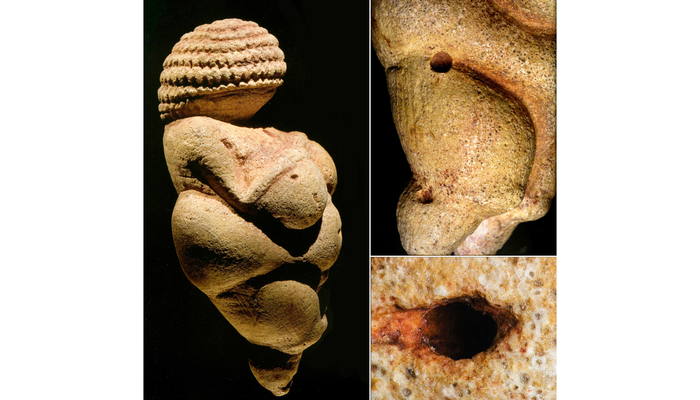The almost 11-cm-high figurine of Venus of Willendorf is one of the most important examples of early art in Europe.
Because it’s made of a rock called oolite, which is not found near Willendorf, Austria, a research team led by the anthropologist Gerhard Weber from the University of Vienna and the two geologists Alexander Lukeneder and Mathias Harzhauser as well as the prehistorian Walpurga Antl-Weiser from the Natural History Museum Vienna have now found out with the help of high-resolution tomographic images that the material from which the Venus was carved likely comes from northern Italy.

This sheds new light on the remarkable mobility of the first modern humans south and north of the Alps. The report “The microstructure and the origin of the Venus from Willendorf” was published in the journal Scientific Reports.
The Venus von Willendorf not only is special in terms of its design, but also in terms of its material. While other Venus figures usually are made of ivory or bone, sometimes also of different stones, oolite was used for the Lower Austrian Venus, which is unique for such cult objects.
Venus of Willendorf
The figurine, which was found in the Wachau in 1908 and is on display in the Natural History Museum in Vienna, has so far only been examined from the outside. Now, more than 100 years later, anthropologist Gerhard Weber from the University of Vienna has used a new method to examine its interior: micro-computed tomography.
Following several passes, the scientists obtained images with a resolution of up to 11.5 micrometers, a quality that is otherwise only seen under a microscope.
“Venus does not look uniform at all on the inside. A special property that could be used to determine its origin,” said Weber.
Along with the two geologists Lukeneder and Harzhauser from the Natural History Museum in Vienna, who had previously worked with oolites, the team procured comparative samples from Austria and Europe and evaluated them. It was a complex project.
Rock samples taken from France to eastern Ukraine, from Germany to Sicily were obtained, sawn, and examined under a microscope. The team was supported by the state of Lower Austria, which provided funds for the time-consuming analyses.
Look inside to learn about the outside
The tomographic data from the Venus showed that the sediments were deposited in the rocks in different densities and sizes. In between, there also were small remnants of shells and six very dense, larger grains, called limonites. The latter explains the previously mysterious hemispherical cavities on the surface of Venus with the same diameter.
“The hard limonites probably broke out when the creator of the Venus was carving it,” explained Weber. “In the case of the Venus navel, he then apparently made it a virtue out of necessity.”
The Venus oolite is porous because the cores of the millions of globules (ooides) of which it is comprised had dissolved. This is an explanation for why the sculptor chose this material 30,000 years ago–it is much easier to work with. The scientists also identified a tiny shell remnant, just 2.5 millimeters long, and dated it to the Jurassic period. This ruled out all other potential deposits of the rock from the much later Miocene geological era, such as those in the nearby Vienna Basin.
Analyzing grain sizes
The research team also analyzed the grain sizes of the other samples. Hundreds, sometimes even thousands of grains were marked and measured with image processing programs or even manually. None of the samples within a 200-kilometer radius of Willendorf even remotely matched. The analysis finally showed that the samples from the Venus were statistically indistinguishable from samples from a location in northern Italy near Lake Garda. This means that the Venus (or at least its material) started a journey from south of the Alps to the Danube north of the Alps.
“People in the Gravettian, the tool culture of the time, looked for and inhabited favorable locations. When the climate or the prey situation changed, they moved on, preferably along rivers,” said Weber.
The statistics clearly point to northern Italy as the origin of the Venus oolite. Nevertheless, there is another interesting place for the origin of the rock. It is in eastern Ukraine, more than 1,600 kilometers (linear distance) from Willendorf. The samples there do not fit as clearly as those from Italy but are better than all the rest of the sample. An interesting connection here is that Venus figures have been found in southern Russia, which are somewhat younger but look very similar to the Venus found in Austria. Genetic results also show that people in Central and Eastern Europe were connected to one another at this time.
The authors of the study are Weber, Lukeneder, Harzhauser, Philipp Mitteroecker, Lisa Wurm, Lisa-Maria Hollaus, Sarah Kainz, Fabian Haack, Walpurga Antl-Weiser, and Anton Kern.




